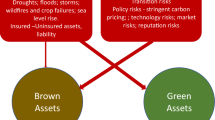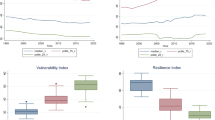Abstract
In this paper, we show how existing IAMs generally omit any representation of a financial sector. We then discuss the potential impacts of climate change policies and climate change events on the financial sector as shown in the existing literature. We underline how the structure of the financial sector itself could impact the carbon trend of the economy. We then see how these specific linkages between the financial and the climate sector can be represented in new types of IAMs, and how they have already started to be addressed, notably in the stock-flow consistent models literature. We conclude on the necessary convergence agenda between climate policies addressing the financial goals in article 2 of the Paris Agreement and financial sector reforms to dampen the intrinsic financial instability.



Similar content being viewed by others
Notes
«Making finance flows consistent with a pathway toward low greenhouse gas emissions and climate-resilient development».
This approach remains in the Decision preceding the Paris Agreement, with the recognition of an objective of 100 billion dollars of annual transfers to be reached by 2020 (paragraph 53).
Many more initiatives can be quoted. They are more systematically described in Aglietta et al. (2016).
An important part of academic debates between climate economists focuses on the «right» value for this discount rate (Espagne et al. 2012).
Following (Kalecki 1971): «The long-run trend is but a slowly changing component of a chain of short-run situations; it has no independant entity».
These economies are characterized in Cahen-Fourot and Lavoie (2016): «Money is created through credit previously to the production process: it anticipates the socially validated production arising from both the market and the non-market sectors. Ultimately, the central bank closes the macroeconomic circuit by refinancing the banks that are in need of central bank money and by lending to the State».
References
Acemoglu, D., P. Aghion, L. Bursztyn, and D. Hemous. 2012. The environment and directed technical change. The American Economic Review 102 (1): 131–166.
Aglietta, M., and E. Espagne. 2016. Climate and finance systemic risks, more than an analogy? The climate fragility hypothesis (No. 2016-10).
Aglietta, M., E. Espagne, B. and Perrissin Fabert. 2016. Finance climat: Le temps de l’action, sept propositions pour la France et l’Europe. Note Terra Nova.
Annicchiarico, B., and F. Di Dio. 2015. Environmental policy and macroeconomic dynamics in a new Keynesian model. Journal of Environmental Economics and Management 69: 1–21.
Annicchiarico, B., and F. Di Dio. 2016. GHG emissions control and monetary policy. Environmental and Resource Economics 67: 1–29.
Batten, S., R. Sowerbutts, and M. Tanaka. 2016. Let’s talk about the weather: The impact of climate change on central banks—Staff Working Paper No. 603. Bank of England.
Balint, T., F. Lamperti, A. Mandel, M. Napoletano, A. Roventini, and A. Sapio. 2017. Complexity and the economics of climate change: A survey and a look forward. Ecological Economics 138: 252–265.
Battiston, S., A. Mandel, I. Monasterolo, F. Schütze, and G. Visentin. 2017. A climate stress-test of the financial system. Nature Climate Change 7 (4): 283–288.
Cahen-Fourot, L., and M. Lavoie. 2016. Ecological monetary economics: a post-Keynesian critique. Ecological Economics 126: 163–168.
Campiglio, E., A. Godin, and S. Kinsella. 2015. The economic implications of the transition to a low-carbon energy system: A stock–flow consistent model. Presentation at the 11th biennial conference of the european society for ecological economics. Leeds, 30/06–03/07 2015.
Carney, M. 2015. Breaking the tragedy of the horizon—climate change and financial stability. Speech given at Lloyd’s of London, September, 29.
Christophers, B. 2017. Climate change and financial instability: Risk disclosure and the problematics of neoliberal governance. Annals of the American Association of Geographers 107: 1–20.
Comerford, D., and A. Spiganti. 2016. The carbon bubble: Climate policy in a fire-sale model of deleveraging. In Bank of England workshop on central banking, climate change and environmental sustainability.
Costanza, R., G. Alperovitz, H. Daly, J. Farley, C. Franco, T. Jackson, … and P. Victor. 2013. Building a sustainable and desirable economy-in-society-in-nature (pp. 126–142). Island Press/Center for Resource Economics.
Dafermos, Y., M. Nikolaidi, and G. Galanis. 2017. A stock–flow–fund ecological macroeconomic model. Ecological Economics 131: 191–207.
Dafermos, Y., M. Nikolaidi, and G. Galanis. 2016. Climate change, financial stability and monetary policy. In Bank of England workshop on central banking, climate change and environmental sustainability.
Dietz, S., and N. Stern. 2015. Endogenous growth, convexity of damage and climate risk: How Nordhaus’ framework supports deep cuts in carbon emissions. The Economic Journal 125 (583): 574–620.
Dietz, S., A. Bowen, C. Dixon, and P. Gradwell. 2016. Climate value at risk of global financial assets. Nature Climate Change 6: 676.
Edenhofer, O., R. Pichs-Madruga, Y. Sokona, E. Farahani, S. Kadner, K. Seyboth, A. Adler, I. Baum, S. Brunner, P. Eickemeier, and B. Kriemann. 2014. IPCC, 2014: summary for policymakers. Climate change.
Eggertsson, G.B., N.R. Mehrotra, and J.A. Robbins. 2017. A model of secular stagnation: Theory and quantitative evaluation (No. w23093). National Bureau of Economic Research.
Espagne, E., B. Perrissin Fabert, A. Pottier, F. Nadaud, and P. Dumas. 2012. Disentangling the Stern/Nordhaus Controversy: Beyond the Discounting Clash. FEEM Working Paper.
Espagne, E., B. Perrissin Fabert, A. Pottier, F. Nadaud, and P. Dumas. 2018. SCCs and the use of IAMs: let’s separate the wheat from the chaff. International Economics (to be published).
Farley, J., M. Burke, G. Flomenhoft, B. Kelly, D.F. Murray, S. Posner, M. Putnam, A. Scanlan, and A. Witham. 2013. Monetary and fiscal policies for a finite planet. Sustainability 5 (6): 2802–2826.
Financial Stability Board. 2016. Global shadow-banking monitoring report 2016. http://www.fsb.org/wp-content/uploads/global-shadow-banking-monitoring-report-2016.pdf.
Golosov, M., J. Hassler, P. Krusell, and A. Tsyvinski. 2014. Optimal taxes on fossil fuel in general equilibrium. Econometrica 82 (1): 41–88.
Hardt, L., and D.W. O’Neill. 2017. Ecological macroeconomic models: Assessing current developments. Ecological Economics 134: 198–211.
Heinen, A., J. Khadan, and E. Strobl. 2016. The Inflationary Costs of Extreme Weather in Developing Countries. Working Paper.
Heutel, G. 2012. How should environmental policy respond to business cycles? Optimal policy under persistent productivity shocks. Review of Economic Dynamics 15 (2): 244–264.
Hsiang, S., R. Kopp, A. Jina, J. Rising, M. Delgado, S. Mohan, D.J. Rasmussen, R. Muir-Wood, P. Wilson, M. Oppenheimer, and K. Larsen. 2017. Estimating economic damage from climate change in the United States. Science 356 (6345): 1362–1369.
Iacoviello, M. 2015. Financial business cycles. Review of Economic Dynamics 18 (1): 140–163.
Jackson, T., and P.A. Victor. 2015. Does credit create a ‘growth imperative’? A quasi-stationary economy with interest-bearing debt. Ecological Economics 120: 32–48.
Jackson, T., P. Victor, and A. Naqvi. 2016. Towards a stock–flow consistent ecological macroeconomics (No. 114). WWW for Europe working paper.
Jakab, Z., and M. Kumhof. 2015. Banks are not intermediaries of loanable funds–and why this matters. IMF Working Paper.
Kalecki, M. 1971. Selected essays on the dynamics of the capitalist economy 1933–1970. CUP Archive.
Matikainen, S., E. Campiglio, and D. Zenghelis. 2017. The climate impact of quantitative easing. Policy Paper. Grantham Research Institute on Climate Change and the Environment, London School of Economics and Political Science.
McLeay, M., A. Radia, and R. Thomas. 2014. Money creation in the modern economy. Bank of England Quarterly Bulletin. 54 (1): 14–27.
Monasterolo, I., S. Battiston, A. Janetos, and Z. Zheng. 2017. Vulnerable yet relevant: The two dimensions of climate-related financial disclosure.
Moyer, E.J., M.D. Woolley, N.J. Matteson, M.J. Glotter, and D.A. Weisbach. 2014. Climate impacts on economic growth as drivers of uncertainty in the social cost of carbon. The Journal of Legal Studies 43 (2): 401–425.
Naqvi, A., and E. Stockhammer. 2017. Directed technological change in a post-Keynesian ecological macromodel (No. PKWP1714). Post Keynesian Economics Study Group (PKSG).
Nikiforos, M., and G. Zezza. 2017. Stock-Flow Consistent Macroeconomic Models: A Survey. Journal of Economic Surveys 31 (5): 1204–1239.
Nordhaus, W.D. 1993. Optimal greenhouse-gas reductions and tax policy in the” DICE” model. The American Economic Review 83 (2): 313–317.
Pollitt, H., and J.F. Mercure. 2017. The role of money and the financial sector in energy-economy models used for assessing climate and energy policy. Climate Policy 18: 1–14.
Pottier, A., J.C. Hourcade, and E. Espagne. 2014. Modelling the redirection of technical change: The pitfalls of incorporeal visions of the economy. Energy Economics 42: 213–218.
Pottier, A. 2016. Comment les économistes réchauffent la planète. Le Seuil.
Rezai, A., L. Taylor, and D. Foley. 2018. Economic growth, income distribution, and climate change. Ecological Economics 146: 164–172.
Safarzyńska, K., and J.C. van den Bergh. 2017. Financial stability at risk due to investing rapidly in renewable energy. Energy Policy 108: 12–20.
Stern, N.H. 2007. The economics of climate change: The Stern review. Cambridge: Cambridge University Press.
Solow, R.M. 1956. A contribution to the theory of economic growth. The Quarterly Journal of Economics 70 (1): 65–94.
Weitzman, M.L. 2009. On modeling and interpreting the economics of catastrophic climate change. The Review of Economics and Statistics 91 (1): 1–19.
Author information
Authors and Affiliations
Corresponding author
Rights and permissions
About this article
Cite this article
Espagne, E. Money, Finance and Climate: The Elusive Quest for a Truly Integrated Assessment Model. Comp Econ Stud 60, 131–143 (2018). https://doi.org/10.1057/s41294-018-0055-7
Published:
Issue Date:
DOI: https://doi.org/10.1057/s41294-018-0055-7




